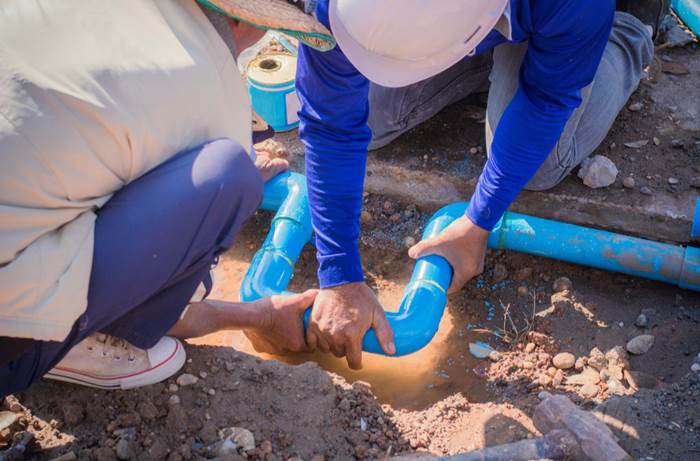Your underground water line is the main water supply to your home, entering at ground level or below. For this reason, you must choose the correct pipe for the purpose.
Imagine the inconvenience if your water line failed to operate… It’s worth making sure you get this pipe installation right.
You actually risk more than an inconvenience with an inadequate underground water line.
The wrong type of pipe could result in costly repairs or damages at a later date. Nobody wants to deal with a leak on their property, do they?
Thankfully, these problems can be easily avoided with little research. Read on to learn about different types of pipe, what size of pipe you should use, and how deep you should bury it.
Once you’ve read this article, you’ll be ready to install your underground water line.
What Type of Pipe is Used for Underground Water Lines?
When choosing the right pipe for an underground water line, you have to consider the conditions to which the pipe will be exposed.
Underground, the environment is moist. The pipe material, then, needs to be especially durable and resistant to moisture.
As the pipe is underground, it may be occasionally hit by a shovel. A pipe that’s easily punctured won’t work under these conditions. You don’t want to be replacing your underground water line too often either.
Longevity is an important concern when choosing the right pipe.
Some underground water lines are especially inaccessible; for example, they might be located under patio slabs.
A pipe that requires frequent repair will cause significant disruption. This is why plumbers look for pipes that will last for this purpose.
There’s no single type of pipe used for underground water lines, but synthetic and metal options are available.
The right material depends on factors such as the climate and site conditions since these can have an impact on pipe performance.
Read on to learn about types of pipe that might be suitable for your underground water line.
Remember to consult local codes before installing such an important pipe, as regulations vary from area to area.
HDPE Pipes

If you’ve ever worked in plumbing, you’ll be familiar with HDPE pipes. They’re used in a range of contexts: industrial, municipal, geothermal, and marine, just to name a few! They may also be used for underground water lines.
What makes HDPE so special? It’s an incredibly strong pipe. This makes it suitable as an underground water line pipe since it doesn’t easily puncture.
It’s very durable, so you shouldn’t have to perform frequent repairs on this important pipe. It offers peace of mind.
You might expect such a durable pipe to also be a very heavy one. In reality, HDPE pipes are lightweight and very flexible. Its flexibility means that it can even be installed without a trench.
HDPE pipes can be fused together very effectively, which means leaks can be avoided! This is a top priority for any underground water line.
If you’re environmentally conscious, you might especially appreciate the fact that HDPE pipes are non-toxic. This makes it a more sustainable solution.
Given that your underground water line is the main water supply for your home, it’s important that your water supply is protected by a non-toxic pipe that’s resistant to corrosion. HDPE pipes fit the bill!
PEX Pipes
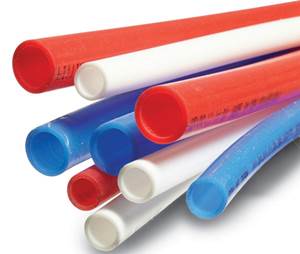
There are many advantages to choosing PEX pipes for your underground water line.
- PEX pipes can be joined using a crimping tool; it’s not necessary to solder them like you would with copper pipes.
- Each supply line has its own shutoff valve, which means it’s easy to isolate leaks if they do occur.
- PEX pipes are considered especially resistant to corrosion and pinholes. They can withstand exposure to the chemicals that are usually present in municipal water systems.
- Because PEX pipes are free of lead, they are considered very safe. For this reason, they’re generally accepted under local regulations when it comes to water distribution.
- PEX pipes can be used for hot and cold water. If they’re going to be exposed to cold conditions, they’re easily insulated.
- It’s a flexible material, which makes it easy to install. This makes it a cost-effective solution. Its flexibility also accommodates slight expansion due to climate, reducing the risk of burst pipes.
Copper Pipes
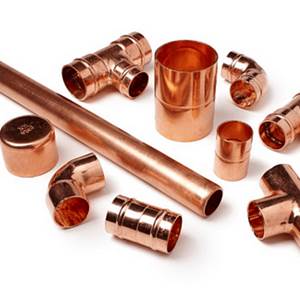
Copper pipes are nothing new; they were the industry standard before plastic pipe alternatives were introduced in the 1970s. In 2021, there are still many reasons to choose this type of pipe for your underground water line.
The number one reason is that copper plumbing pipes are known for their durability. You can expect them to last between 50 and 70 years, depending on climate and the quality of water that they’re used to transport.
That means if you install copper pipes once, you might not have to interfere with your plumbing system for the rest of your life!
No wonder so many homeowners opt for copper when it’s time to replace their underground water line.
Copper plumbing pipes can handle extreme temperatures. They’re less likely to freeze and burst compared to other types of pipe. Although acidic water can affect them, they’re generally considered very resistant to corrosion.
The reason copper pipes haven’t become obsolete with the introduction of alternatives – like lead, iron, and galvanized steel did – is because they are safe to use. They won’t contaminate your water.
They’re also resistant to fire and they can be recycled.
Since copper pipes can be installed outside, this material is a good candidate for an underground water line.
PVC Pipes
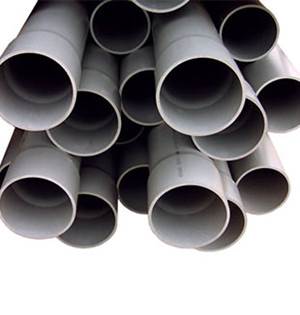
You might consider using PVC pipes for your underground water line. This material is certainly sturdy and durable enough for the job.
Using PVC mitigates the risk of the pipes corroding, and this is a very versatile material that can be used for a variety of purposes.
PVC is very resilient so is unlikely to require much in the way of repair or maintenance. It’s also very light when compared to metal pipes of equivalent size.
Although it could still be considered fairly expensive, it will cost less than copper pipes most of the time. PVC pipes might be the best option if you’re on a budget.
You should check your own local regulations, but PVC is usually approved for underground use. It can’t be used for indoor distribution. It’s able to handle high water pressure.
These characteristics are what make it an ideal option for an underground water line.
How Deep Should You Bury Water Lines?
So, you’ve chosen the right material for your water line. Now, it’s time to take it underground. You must position this pipe correctly since it connects the municipal water supply to your house.
The reason these pipes must be buried is that otherwise, the water inside is liable to freeze. At a certain level, the soil acts as a natural insulator. This prevents pipes from freezing in cold climates.
You need to check your building codes to know exactly how deep this pipe should be buried. You may also wish to consult your local water authority.
In general, supply pipes have to be buried below the frost line for your area.
It’s common knowledge that pipes should be buried at least 12 inches below the local frost depth.
However, you should confirm the rules of your specific area before you start digging the trench for your waterline.
If you thwart local codes, there may be consequences! Remember, these codes are in place to protect your pipes. It’s a good idea to get familiar with them if you’re undertaking any external plumbing work.
What Size Pipe is Used for Underground Water Lines?
The standard pipe size used for underground water lines can vary between different areas; however, in general, a main water line pipe is a 3/4 inch pipe.
You might consider upgrading this a little. If you opt for a 1-inch pipe instead, you’ll enjoy a higher volume of water flowing into your house.
Going any smaller than a 3/4 inch pipe is inadvisable. Why? Because you’d reduce the volume of water coming to your house.
However, you would, of course, increase the water pressure. Volume is usually more of a concern than pressure when it comes to underground water lines.
To improve the water pressure in your home, you don’t have to interfere with the size of your underground water line. Instead, look at reducing the size of the interior pipes in your home.
This way, you can enjoy the perfect balance between pressure and volume.
How to Prevent Underground Water Pipes From Freezing:
Your underground water pipe should be protected against the possibility of freezing.
Imagine the situation: cold weather causes your pipes to freeze at the harshest moment of winter. This stops water from entering your home.
The ground is entirely frozen too, so it’s extra difficult to dig up the ground and replace the pipe. Sound like fun? Not at all!
The first step you can take to prevent your underground water pipes from freezing is to bury them at the correct level.
The reason there are regulations regarding this is that, at a certain level, soil naturally insulates your pipe.
Install your underground water pipe at least 12 inches beneath the local frost depth to protect it.
You can also insulate your pipes further as an extra preventative measure. Keep reading to learn about the methods of insulation available.
Can Foam Pipe Insulation Be Used Underground?
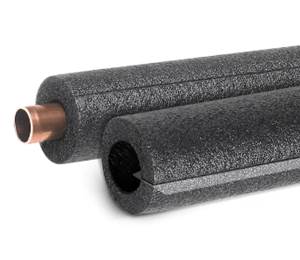
Maybe you’ve used foam pipe insulation in the past and you’re wondering whether it can be applied to an underground water line.
The answer is yes, it can be used in this context. However, it’s not the ideal material for this purpose. To maximize its effectiveness, make sure the insulation is very thick.
Cover and seal it comprehensively to protect it from water damage.
If possible, buy a brand of foam insulation that’s made for underground use. These tend to have additional sealing features that add an extra layer of protection.
How Do You Insulate Underground Water Lines?
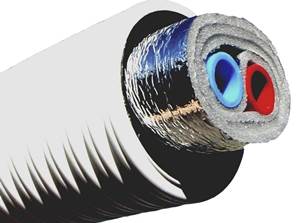
If you want to insulate your underground water line, you have 2 options. You can either use watertight insulation or non-watertight insulation. Let’s compare them!
Watertight insulation protects to a higher level against freezing temperatures, preventing pipes from bursting. This method feeds your water pipe through a larger pipe that is filled with insulation.
This is watertight because of the extra layer of pipe. It means your insulation will last longer. PVC pipes are often used for this purpose.
Non-watertight insulation needs a slightly deeper trench. You dig 3 inches further and add 3 inches of gravel to fill this space.
The idea is that this gravel will drain ground water away, diverting it from your pipe and its insulation.
To install this, you’ll use plastic sheeting to line your trench and foam board to insulate your pipe.
All around the water line, you’ll place about 4 inches of foam board.
The plastic sheeting wraps around both the pipes and the insulation and then it is secured in place before the trench is filled.
Does Foam Pipe Insulation Prevent Freezing?
Even with insulation, there’s no guarantee that your pipe won’t freeze in harsh weather conditions.
This is why it’s especially important to choose the right material and install the water line at the right level underground.
Foam pipe insulation is still superior to no insulation at all, even if it isn’t 100% effective.
Some pipes benefit from an electric heat tracing system which helps maintain safe temperatures and avoid burst pipes. You might consider exploring this option.
Now, you’re more than prepared to get your underground water line installed. No matter what material you choose, make sure it’s buried at the right level for your local area.
This is how you avoid freezing pipes and costly repairs!
REFERENCES
https://isco-pipe.com/pipe/ https://www.benjaminfranklinplumbing.com/ https://www.achrnews.com/

